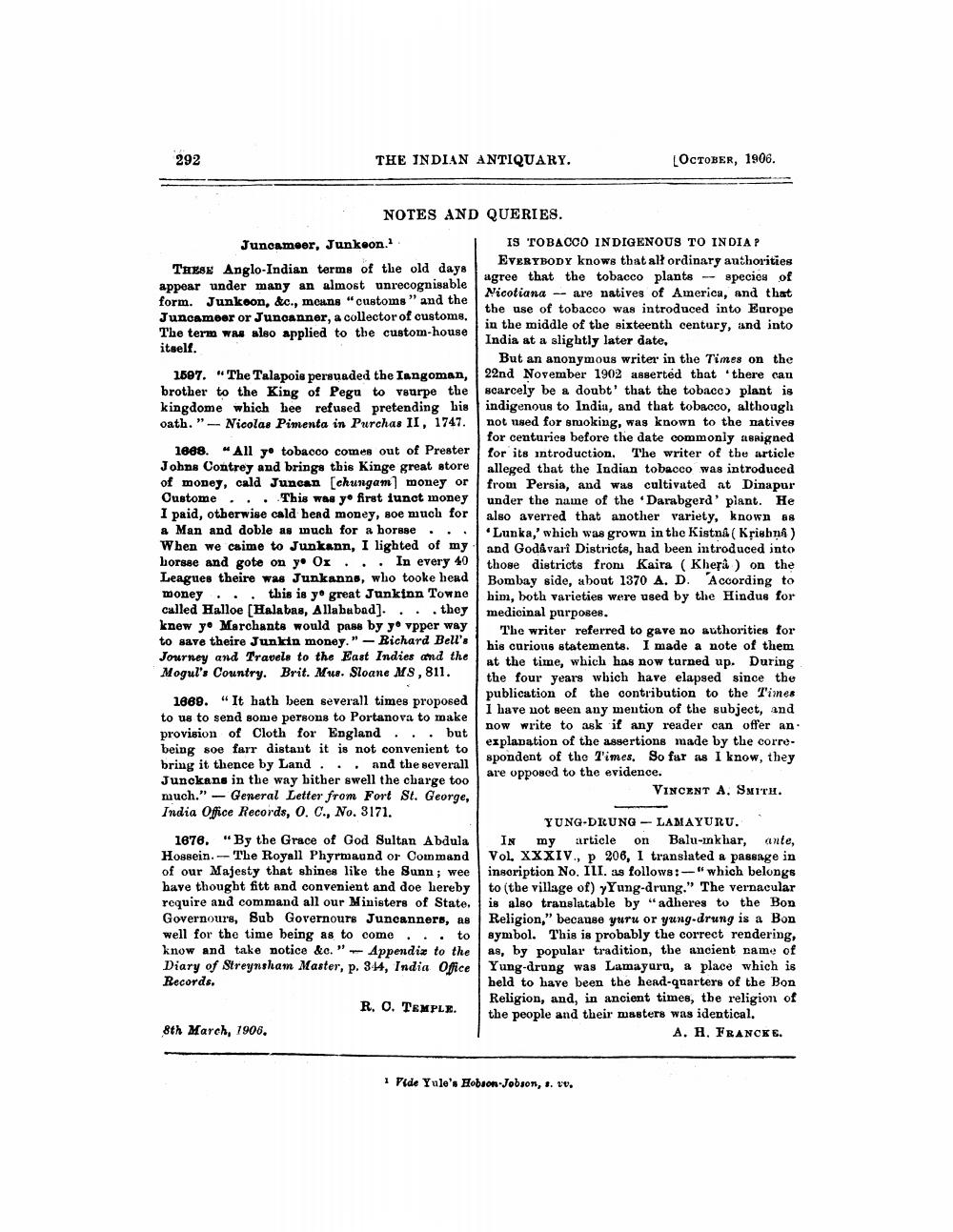________________
292
THE INDIAN ANTIQUARY.
NOTES AND QUERIES.
Juncameer, Junkoon.1
THESE Anglo-Indian terms of the old days appear under many an almost unrecognisable form. Junkeon, &c., means "customs" and the Juncameer or Juncanner, a collector of customs. The term was also applied to the custom-house itself.
1597. "The Talapois persuaded the Iangoman, brother to the King of Pegu to vsurpe the kingdome which hee refused pretending his oath." Nicolas Pimenta in Purchas II, 1747.
1668. "All ye tobacco comes out of Prester Johns Contrey and brings this Kinge great store of money, cald Juncan [chungam] money or Custome... This was ye first iunct money I paid, otherwise cald head money, soe much for a Man and doble as much for a horsse When we caime to Junkann, I lighted of my horsse and gote on y Ox. . . In every 40 Leagues theire was Junkanns, who tooke head money ... this is ye great Junkinn Towne called Halloe [Halabas, Allahabad]....they knew ye Marchants would pass by yo vpper way to save theire Junkin money."- Richard Bell's Journey and Travels to the East Indies and the Mogul's Country. Brit. Mus. Sloane MS, 811.
1889. "It hath been severall times proposed
to us to send some persons to Portanova to make provision of Cloth for England... but being soe farr distant it is not convenient to bring it thence by Land... and the severall Junckans in the way hither swell the charge too much." General Letter from Fort St. George, India Office Records, O. C., No. 3171.
8th March, 1906.
1876. "By the Grace of God Sultan Abdula Hossein. The Royall Phyrmaund or Command of our Majesty that shines like the Sunn; wee have thought fitt and convenient and doe hereby require and command all our Ministers of State. Governours, Sub Governours Juncanners, as well for the time being as to come know and take notice &c. 31 Appendix to the Diary of Streynsham Master, p. 344, India Office Records.
to
R. O. TEMPLE.
LOCTOBER, 1906.
IS TOBACCO INDIGENOUS TO INDIA P EVERYBODY knows that all ordinary authorities agree that the tobacco plants-species of Nicotiana are natives of America, and that the use of tobacco was introduced into Europe in the middle of the sixteenth century, and into India at a slightly later date,
But an anonymous writer in the Times on the 22nd November 1902 asserted that there can scarcely be a doubt that the tobacco plant is indigenous to India, and that tobacco, although not used for smoking, was known to the natives for centuries before the date commonly assigned for its introduction. The writer of the article alleged that the Indian tobacco was introduced from Persia, and was cultivated at Dinapur under the name of the Darabgerd' plant. He also averred that another variety, known as 'Lunka,' which was grown in the Kistna ( Krishna) and Godavari Districts, had been introduced into those districts from Kaira (Khera) on the Bombay side, about 1370 A. D. According to him, both varieties were used by the Hindus for medicinal purposes.
The writer referred to gave no authorities for his curious statements. I made a note of them at the time, which has now turned up. During the four years which have elapsed since the publication of the contribution to the Times
I have not seen any mention of the subject, and
now write to ask if any reader can offer an. explanation of the assertions made by the correspondent of the Times. So far as I know, they are opposed to the evidence.
VINCENT A. SMITH.
YUNG-DRUNG-LAMAYURU. IN my article on Balu-mkhar, ante, Vol. XXXIV., p 206, I translated a passage in inscription No. III. as follows:-"which belongs to (the village of) yYung-drung." The vernacular is also translatable by "adheres to the Bon Religion," because yuru or yung-drung is a Bon symbol. This is probably the correct rendering, as, by popular tradition, the ancient name of Yung-drung was Lamayuru, a place which is held to have been the head-quarters of the Bon Religion, and, in ancient times, the religion of the people and their masters was identical. A. H. FRANCKE.
1 Fide Yule's Hobson-Jobson, s. vv.




